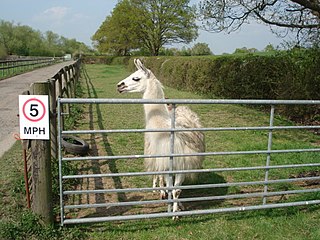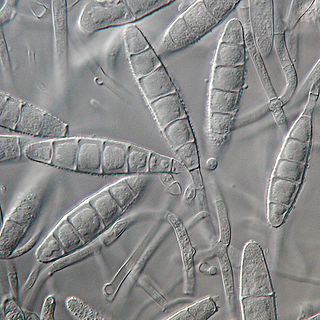 W
WAleutian disease, also known as mink plasmacytosis, is a disease which causes spontaneous abortion and death in minks and ferrets. It is caused by Carnivore amdoparvovirus 1, a highly contagious parvovirus in the genus Amdoparvovirus. The virus has been found as a natural infection in the Mustelidae family within mink, ferrets, otters, polecats, stone and pine martens and within other carnivores such as skunks, genets, foxes and raccoons. This is most commonly explained as because they all share resources and habitats.
 W
WBalloon syndrome is a rare condition in hedgehogs in which gas is trapped under the skin as a result of injury or infection, causing the animal to inflate. It is akin to surgical emphysema seen in humans, although somewhat more profound in hedgehogs due to their tissue structure. The British Hedgehog Preservation Society describes the symptoms as: "Hedgehog has blown up appearance, subcutaneous emphysema".
 W
WBerserk llama syndrome, aberrant behavior syndrome, or berserk male syndrome is a psychological condition suffered by human-raised camelids, particularly llamas and alpacas, that can cause them to exhibit dangerously aggressive behavior toward humans. The term has been overused, however, and is sometimes inappropriately applied to llamas with aggressive personalities that are not truly "berserk".
 W
WChlamydia abortus is a species in Chlamydiae that causes abortion and fetal death in mammals, including humans. Chlamydia abortus was renamed in 1999 as Chlamydophila psittaci along with all Chlamydiae except Chlamydia trachomatis. This was based on a lack of evident glycogen production and on resistance to the antibiotic sulfadiazine. In 1999 C. psittaci and C. abortus were recognized as distinct species based on differences of pathogenicity and DNA–DNA hybridization. In 2015, this new name was reverted to Chlamydia.
 W
WDevil facial tumour disease (DFTD) is an aggressive non-viral clonally transmissible cancer which affects Tasmanian devils, a marsupial native to Australia. DFTD was first described in 1996. In the subsequent decade the disease ravaged Tasmania's wild devils. Affected high-density populations suffered up to 100% mortality in 12–18 months. Between 1996 and 2015, DFTD wiped out 95% of affected populations.
 W
WInfectious necrotic hepatitis is a disease of large animals, especially sheep, caused by Clostridium novyi infection. The primary infection is intestinal and transferred by the faecal-oral route. Spores of C. novyi escape from the gut and lodge in the liver, where they remain dormant until some injury creates anaerobic conditions for them to germinate, causing local necrosis and widespread damage to the microvascular system, resulting in subcutaneous bleeding and blackening of the skin, hence the common name "black disease".
 W
WLeptospirosis is a blood infection caused by the bacteria Leptospira. Signs and symptoms can range from none to mild to severe. Weil's disease, the acute, severe form of leptospirosis, causes the infected individual to become jaundiced, develop kidney failure, and bleed. Bleeding from the lungs associated with leptospirosis is known as "severe pulmonary haemorrhage syndrome".
 W
WMicrosporum gypseum is a soil-associated dermatophyte that occasionally is known to colonise and infect the upper dead layers of the skin of mammals. The name refers to an asexual "form-taxon" that has been associated with four related biological species of fungi: the pathogenic taxa Arthroderma incurvatum, A. gypsea, A. fulva and the non-pathogenic saprotroph A. corniculata. More recent studies have restricted M. gypseum to two teleomorphic species A. gypseum and A. incurvatum. The conidial states of A. fulva and A. corniculata have been assigned to M. fulvum and M. boullardii. Because the anamorphic states of these fungi are so similar, they can be identified reliably only by mating. Two mating strains have been discovered, "+" and "–". The classification of this species has been based on the characteristically rough-walled, blunt, club-shaped, multicelled macroconidia. Synonyms include Achorion gypseum, Microsporum flavescens, M. scorteum, and M. xanthodes. There has been past nomenclatural confusion in the usage of the generic names Microsporum and Microsporon.
 W
WNeonatal isoerythrolysis, also known as hemolytic icterus or hemolytic anemia, is a disease most commonly seen in kittens and foals, but has also been reported in puppies. It occurs when the mother has antibodies against the blood type of the newborn.
 W
WParasitic bronchitis, also known as hoose, husk, or verminous bronchitis, is a disease of sheep, cattle, goats, and swine caused by the presence of various species of parasite, commonly known as lungworms, in the bronchial tubes or in the lungs. It is marked by cough, dyspnea, anorexia and constipation. Lungworms which cause parasitic bronchitis include nematodes of the genera Dictyocaulus, Metastrongylus, and Protostrongylus. Hoose is essentially an infantile disease, almost always afflicting animals under one year of age.
 W
WPhocine morbillivirus, formerly Phocine distemper virus (PDV), is a paramyxovirus of the genus Morbillivirus that is pathogenic for pinniped species, particularly seals. Clinical signs include laboured breathing, fever and nervous symptoms.
 W
WA teat is the projection from the mammary glands of mammals from which milk flows or is ejected for the purpose of feeding young. In many mammals the teat projects from the udder. The number of teats vary by mammalian species and often corresponds to the size of an average litter for that animal. In some cases, the teats of female animals are milked for the purpose of human consumption.
 W
WToxascaris leonina is a common parasitic roundworm found in dogs, cats, foxes, and related host species. Toxascaris leonina, or T. leonina, is an ascarid nematode, a worldwide distributed helminth parasite which is in a division of eukaryotic parasites that, unlike external parasites such as lice and fleas, live inside their host. The definitive hosts of T. leonina include canids and felines (cats), while the intermediate hosts are usually rodents, such as mice or rats. Infection occurs in the definitive host when the animal eats an infected rodent. While T. leonina can occur in either dogs or cats, it is far more frequent in cats.